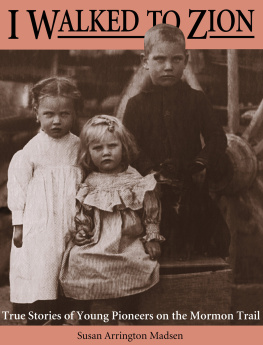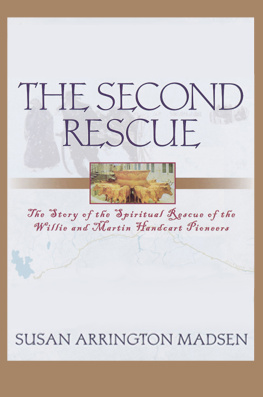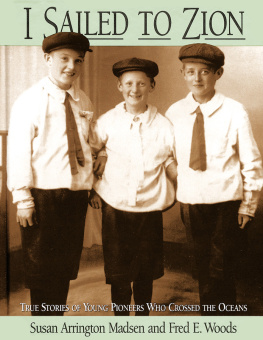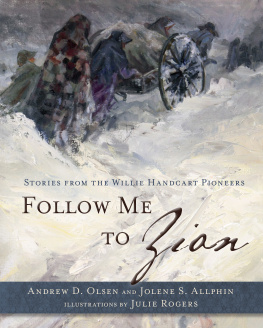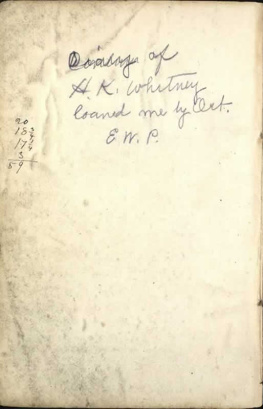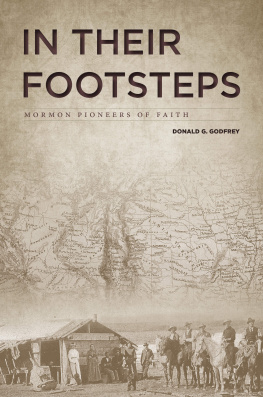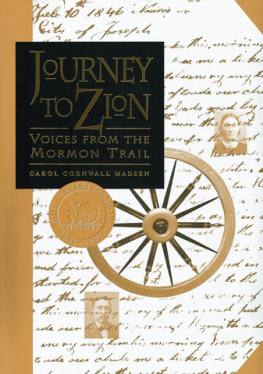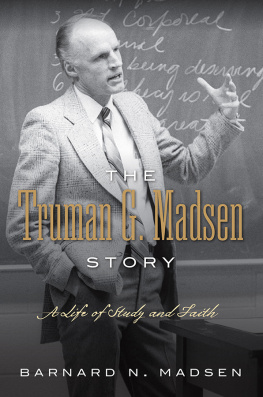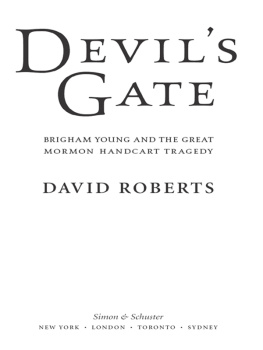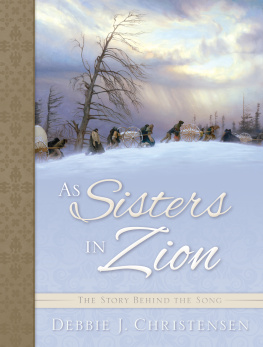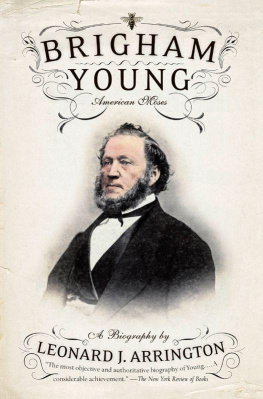I Walked to Zion
True Stories of Young Pioneers on the Mormon Trail
Susan Arrington Madsen
1994 Deseret Book Company.
All rights reserved. No part of this book may be reproduced in any form or by any means without permission in writing from the publisher, Deseret Book Company, P.O. Box 30178, Salt Lake City Utah 30178. This work is not an official publication of The Church of Jesus Christ of Latter-day Saints. The views expressed herein are the responsibility of the author and do not necessarily represent the position of the Church or of Deseret Book. Deseret Book is a registered trademark of Deseret Book Company.
Preface
The Mormon Trail, from Winter Quarters, Nebraska, to the Great Salt Lake Valley, is more than a thousand miles long. It's hard to imagine walking a thousand milesespecially if one must walk that far as quickly as possible, before supplies run out and before the snow flies. But between 1847 and 1869, more than seventy thousand Latter-day Saint pioneers made the trek, seeking religious freedom, with most of them walking every step of the way.
Few pioneers rode in the oxen-pulled covered wagons they used. Riding was reserved for the very young, the very old, and those too sick to take another step. The load had to be kept as light as possible for the patient but weary oxen. The Edwin D. Woolley family had a pregnant sow riding in the back of their wagon for a short time, hoping to save the piglets soon to be born. Chickens got to ride. They bounced along in small coops, tied to the sides of the wagons. But most of the courageous travelers walked to the Salt Lake Valley, arriving with sore, blistered feet. Some didn't make it at all.
Many books have been written about the westward journey of the early Latter-day Saintsoften called one of the greatest epics in American history. In most of these books, however, children and teenagers are rarely seen and almost never heard. This volume takes a look at the migration from the perspective of young people who experienced the great LDS exodus.
What was the emigration experience like for those young pioneers whose eyes viewed the Mormon Trail from only three or four feet off the ground? What did they think of the journey? What did they do for fun? What were their fears? What about those who traveled without their parents? What did they think when they finally saw their dreamed-of destinationthe Salt Lake Valley?
The answers to these and other questions are found in the journals and personal histories of young emigrants who crossed the Great Plains on the Mormon Trail. In preparing this book, I studied more than a hundred such sources, including ones that featured people in their late teens. In the middle 1800s, teenagers sixteen and older were generally viewed as adults, but I decided to include them because they make interesting and valuable comparisons with their peers of today. Most of the accounts I examined were written years after the incidents in them occurredvery few children or teens managed to keep a journal along the way.
To capture the magic of personal experience, I have chosen to include only first-person accounts of the trek. Who can better describe enduring the sweltering heat, the hunger, the mud, the insects or experiencing the humor and the romance of the journey than the youth who walked beside or behind the wagon? Who can better describe what was felt when a young girl was buried on the plains than her playmate who stood at the side of the shallow grave and said a last good-bye? She was there.
Only one account in this collection was written by an adult making the trek. Mary Ann Weston Maughan saw her three-year-old son, Peter, die beneath the wheels of their wagon. Her account of that experience is important in appreciating that children also made the supreme sacrifice.
For many, the journey to Zion began in their native lands far across the ocean. I have chosen to include several accounts of young people who describe leaving homes and relatives abroad and living on sailing vessels bound for America.
For readability, I have standardized spelling and punctuation, but otherwise, I have not changed wording except when necessary to clarify the meaning of a sentence. I have also deleted sentences and phrases in places not critical to the actual narrative, especially in larger chapters. In the chapter titles I have included in parentheses the future married names of the young women who made the trek because many of them are better known by those names than by their maiden names.
For the most part, these excerpts recount only the portion of the individuals' personal histories that dealt with the emigration to the Salt Lake Valley. For those desiring to read more, the title and location of the material have been provided at the end of each chapter.
Many people made this book possible. I have in particular relied on the previous research done by such excellent historians as Elliott West, University of Arkansas; Stanley B. Kimball, Southern Illinois University, and his wife, Violet; and S. George Ellsworth, Utah State University (see "References" at back of this book).
I am deeply grateful to the staff of the library and archives of the Church Historical Department in Salt Lake City, especially William Slaughter. I also appreciate the generous assistance of A. J. Simmonds and his associates in Special Collections at the Merrill Library at Utah State University.
Those who gave excellent research suggestions include my father, Leonard J. Arrington; Lyndia Carter, Oregon-California Trails Association; William G. Hartley and Richard Jensen, Joseph Fielding Smith Institute for Church History at Brigham Young University; Dorothy C. Hudman, Family History Library, Salt Lake City; Reed Durham and Kenneth Godfrey, LDS Institute of Religion in Logan; Norda Emmett; Ella Madsen; Doris Reeder; and Daina Zollinger.
I especially appreciate the valuable editing suggestions provided by Willis L. Pitkin, Jr., of the English Department at Utah State University.
James C. Jacobs, professor of children's literature at Brigham Young University, was a driving force behind this project from the very beginning. Without his encouragement and confidence, I might never have attempted this project.
As always, my friend and eternal companion, Dean, was constantly supportive, enthusiastic, and helpful. Thank you so muchteamwork means everything.
One of my wishes for our four treasured daughters, Emily, Rebecca, Sarah and Rachel, is that they will learn, as I have, to love and cherish the history of The Church of Jesus Christ of Latter-day Saints. This project has been a profound and sometimes emotional experience for me. It has increased my reverence for the human spirit and deepened my testimony of the truth of the restored gospel of Jesus Christ.
May this book serve as a reminder of the high and noble price that has been paid for the kingdom to go forth and of the ultimate joy and meaning of such sacrifice.
Susan Arrington Madsen
Hyde Park, Utah
February 9, 1994
The Mormon Trail
"And it shall come to pass in the last days, that the mountain of the Lord's house shall be established in the top of the mountains, and shall be exalted above the hills; and all nations shall flow unto it."
Isaiah 2:2
In 1844, Rachel Emma Woolley (Simmons) was seven years old when she was taken to the Mansion House in Nauvoo, Illinois, to view the bodies of the Prophet Joseph Smith and his brother Hyrum. Her uncle Samuel Woolley lifted her up beside the two coffins lined with black velvet, and she gazed through the hinged glass lids at the faces of those two great leaders.

